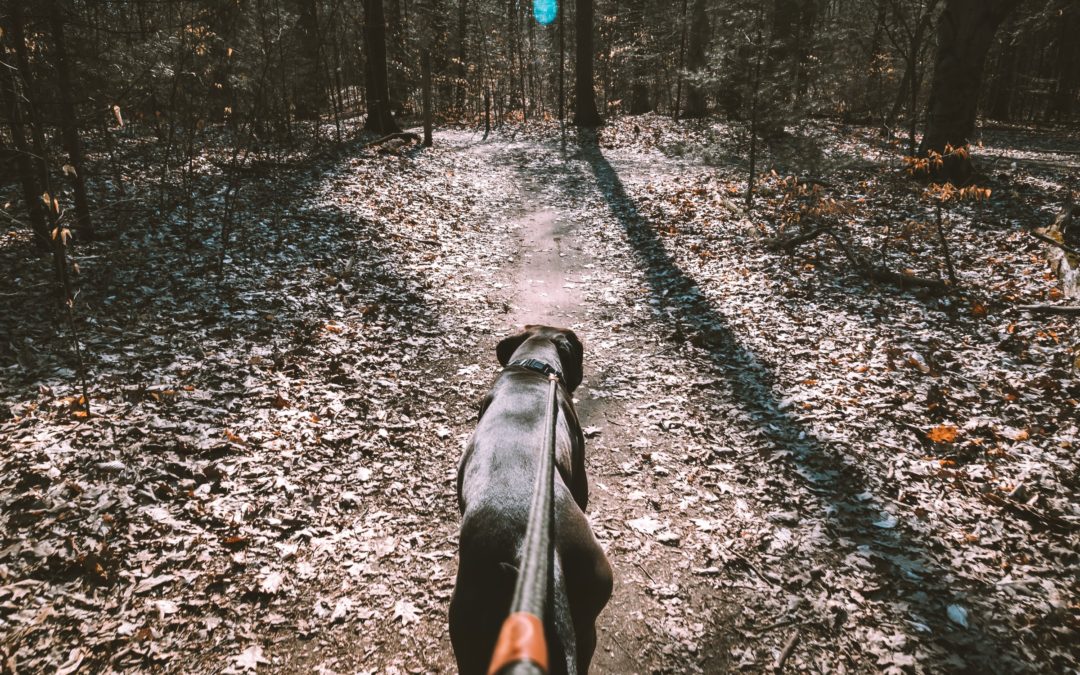Does your dog pull on the leash every time you go for a walk? It can be frustrating for you and your dog when walks are a constant tug battle, but it doesn’t have to be that way. There are lots of ways you can teach your dog to walk closer to you. We’ll start with this simple method!
Why does my dog pull on the leash?
Before we can replace the pulling behavior, we have to ask why it’s happening. Your dog pulls on the leash because it works. Your dog’s goal is to get to where they want to go, and tugging at their leash gets them there. Every time you keep walking when your dog pulls, she learns that pulling works. Therefore, you need to stop reinforcing that pulling works, and instead give your dog a new way to walk.
How to stop your dog from pulling on the leash
First, you’ll need to stop teaching your dog that pulling works. When your dog pulls on her leash, you should stop walking. This will lead to some uneventful walks the first few times. There will be a lot of start and stop, and you may not get very far, but it is important that you are consistent. Dog training is all about repetition. If sometimes pulling works and sometimes it doesn’t, that will only lead to more confusion and frustration from your dog.
Since pulling isn’t going to work anymore, you need to show your dog what will work. You’ll need to get some tasty treats – something your dog really likes. Carry a treat pouch with you on walks so you have them ready to reward your dog! Positive reinforcement is how you can communicate with your dog. It is your language for telling them what you want them to do. Hold a treat out right beside you and wait for your dog to come get it. As you walk, whenever your dog returns to that zone by your side, give her a reward. You’re showing your dog that right next to you is the place to be! This is where the good stuff happens.
Your dog will start to see the spot by your side as a home base and return to check in with you. They don’t need to be right in that spot the whole walk – they can still meander and sniff the grass – but they will start to stay closer to you since they know that’s where the treats are. You’ll notice your dog spending less time at the end of their leash and more time close by.
Whenever you go for a walk, you ideally want to prevent the dog from pulling from the very beginning. Have those treats ready the second you step out of the house. Stop on the porch or stoop and wait for you dog to check in and reward them for their attention!
Tip: It’s a great idea to begin your leash training right in your home. You can put your dog on leash and walk around the house or in the yard. This will reduce the number of distractions so you can focus on establishing the new walking routine.
What kind of gear do you need?
Your leash should be a fixed length. Retractable leashes are popular, but they mean that your dog’s boundaries are constantly changing. That can be confusing for your dog and make it harder for them to understand what you are asking of them.
We also recommend a harness that attaches to the leash in the front. When your leash clips to a harness in the back between their shoulders, your dog can pull ahead without looking back at you. When the leash clips directly to their collar, your dog can even injure their neck when they pull. A front-clip harness is safer and actually makes the dog’s chest pivot back towards you when they feel a tug. That creates an opportunity for them to look at you to check in.
We’re here for you!
We offer private lessons in person and by phone/video, and offer a variety of group training classes that cover leash walking and many more topics. Email us at train@paws4ever.org if you have questions or need help deciding which training class is right for your dog!


We were always taught to reverse /change direction when the dog was pulling on the leash. Comment?
Hi Courtenay and thanks for the great question! There are lots of older routines that may have some value, but don’t help the dog learn they why’s and wherefore’s of what we are trying to convey. If you have your dog on a standard leash and collar, they pull out to the front and then you turn and abruptly start walking the other way then the dog is going to get a nasty jerk on the neck and likely still not get the message that staying with you gets them where they want to go (since it didn’t). We like for our walks to be a cooperative exercise where “I don’t pull you and you don’t pull me”. We’re happy to talk about this further or answer any other questions you may have!